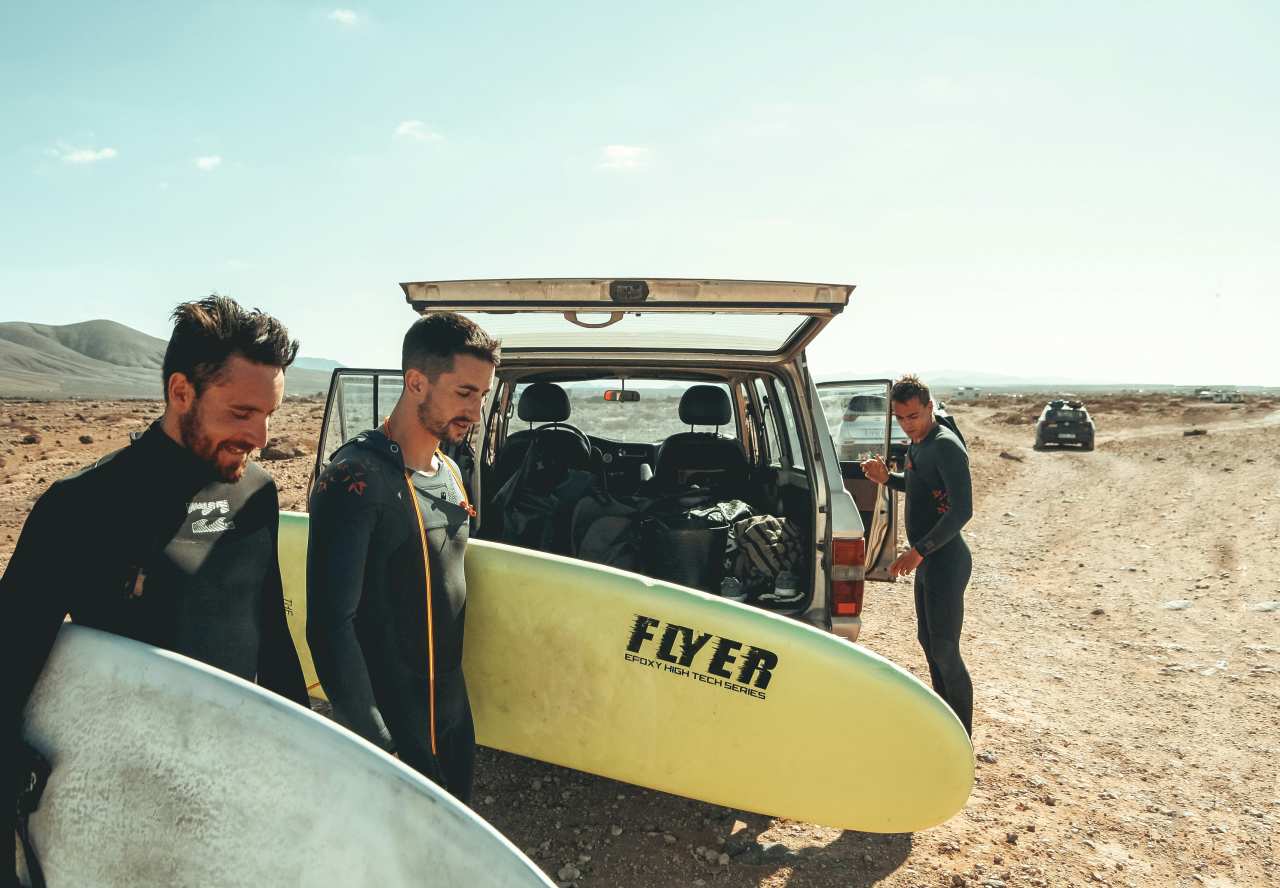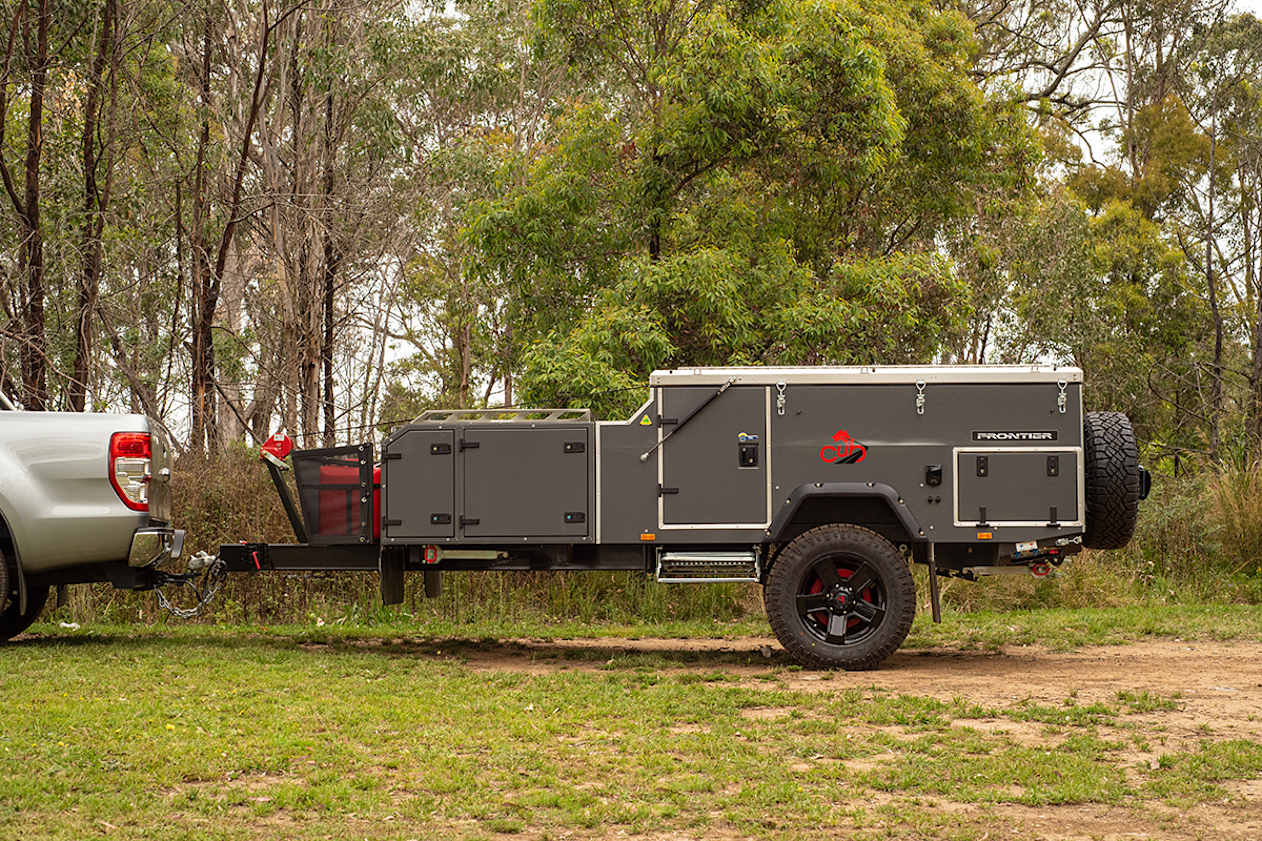When Cub Campers first released the Frontier in 2018, its first forward-fold camper trailer, it was almost in a league of its own. The only other camper trailer with a vaguely similar concept was the Ultimate Camper, but Ultimate barely innovated in 20 years, and so there’s little surprise the company was bailed out of voluntary administration a year ago.
Cub’s Frontier brought a breath of fresh, well-engineered air to the market that I think is more accurately described as “canvas-roofed campers that have a couch” (so catchy).
Of the campers built in Australia – including the Patriot X3, Ultimate Camper, Cub Frontier and Cub Drifter – the Frontier sits at the lower end in price and spec. But is that a bad thing?
How big is this camper-trailer? How much does it weigh?
The Cub Frontier is light for a “canvas-roofed camper that has a couch”. With a tare weight of 1230kg, it shaves nearly 200kg off what you’d expect from an imported version.
It can carry over 670kg of gear. By comparison, the Patriot Campers X3 is 1120kg. Taking an imported example, the Opus Air OP2 is 1415kg and one of the lightest forward-fold trailers coming from overseas. The fibreglass-bodied Ultimate Campers trump them all, though, weighing less than 1000kg.
The Frontier is one of Cub’s larger campers. It measures 5.5m long, is 1.94m wide and 1.6m high.
| Length | 5500mm |
| Width | 1920mm |
| Height | 1600mm |
| Weight (Tare/ATM/Tow Ball) | From 1230kg/1900kg/145kg |
How easy is it to set up?
Far and away, the Cub is the easiest-to-set-up forward-folding camper, and I’m constantly surprised that other manufacturers haven’t copied the concept yet. Most imported campers (potentially all, apart from the Opus which has pneumatic poles) require some level of pole adjustment to get the tent taut (on second thought, that is a lot of pole adjustment), Cub has engineered its frame, so that’s not needed.
After unclipping the lid, when you wind in the winch, the roof is pulled over. Once the roof is over-centre, the winch continues to pull it into place, and all that’s left to do is push the rear tent bow out, tidy up the overhanging canvas weather flaps, and the tent is done.
Inside, the cushions for the wraparound lounge need arranging, and the straps holding the bed in place can be undone. It’s a very painless set-up.
There’s one thing to note on pack-up, though. Largely, the process is straightforward. The same mechanisms that open the trailer up also help close it. However, it’s imperative that you close the door first. On most forward-fold campers, if you leave the door open, you’ll have to open the camper up again to close it, which is frustrating, but that’s all.
On the Cub, which has a side-hinged rather than bottom-hinged door, if you forget, as I did, you’ll bend the gas strut over the top hinge. It’s $140 to replace one, so not overly problematic, but certainly far from ideal.
There are a few possible solutions to this, I believe. Most obvious is to copy the status quo and move the hinges to the bottom, although that means the camper will have a full canvas door, which is less elegant. Alternatively, Cub could move the hinges lower on the door so that the strut slides between it and the campers frame if you accidentally make the same mistake as I did. Or, just remember to close the door.
So, in summation: remember to close the door before you start packing up the trailer. Don’t say I didn’t warn you!
How practical is the space inside?
Cub set the bar high when it released the Frontier and the living areas, which encompass the bed, living area and the kitchen under the awning, are thoughtfully appointed. In the living room, for example, the table is fully adjustable up, down, across and round and round. A simple foot pedal allows it to be compressed to create the second bed area, or you can shift it out of the way to allow easier access to the seating.
There are six internal storage boxes under the foot of the bed, so it’s easy to keep clothes and everyday items organised in a convenient location. There’s also a small storage space under the little step that makes climbing into bed easier.
If privacy is needed, the bedroom and living areas can be divided by a canvas curtain, while both are lit independently by LED strip lights on the tent frames or thanks to the large windows.
If you prefer a much more open layout, the panel over the kitchen opens right up so you can take in the view.
What is the bed like?
The Cub Frontier’s bed is quite good, as it’s a pocket spring as standard, rather than the usual high-density foam expected on most campers. It doesn’t fill the whole area, leaving space for the tent frame and canvas to fit around it and therefore make it easier to pack up. I’d love to see some little storage areas here too, but there are 12V and USB points in convenient places.
The second bed is easy to make: you simply push down the table and rearrange the cushions to suit. Because the cushions are all flat, there are no lumps in the bed, but some non-stick backing would prevent them from shifting too much when someone’s asleep on them.
What’s the kitchen like?
The Cub Frontier kitchen is excellent, although, on this test, it had come off its rails and was stuck in the storage space, so I wasn’t able to thoroughly inspect it. I did appreciate the integrated bottle opener, though, and felt it might have helped overcome my disappointment after I bent the gas strut on pack-up. But I didn’t have any beers with me – for shame. On further investigation, it turned out that an over-enthusiastic potential customer had pushed it off the rails while viewing it in the showroom, and no one had noticed until I tried to open it.
I have used the Frontier’s kitchen before, though. It (usually) slides out from the back of the camper and is supported by a fold-down leg. A bench extension folds over, doubling the available space so you can use the stove and sink unobstructed. 12-volt water and gas are plumbed to the kitchen.
Forward of the main door is where the fridge is stored, and that’s accompanied by a large pull-out pantry drawer which I think is excellent.
How easy is it to tow?
A lot of forward-fold camper trailers are front heavy with overly tall suspension and questionable towing balance, but Cub’s commitment to engineering and the trailers overall lightweight spares the Frontier from those criticisms. It is still weighty on the ball for a camper trailer, but not overly so. 145kg at tare is a good figure amongst its peers. It’s fitted with Cub-developed independent, coil-spring suspension which rides really well over highways or byways. Because it’s not overly high, it doesn’t have that ugly, nose-down stance I often observe of cheaper forward-fold campers.
What options are available for it?

There are two upgrade packs available for the Cub Frontier. The first is the Xtreme Off Road pack, which adds 265/70R17 Goodyear Mud Terrain tyres, a DO35 hitch and driver-side utility outlets to the camper. The Frontier Pack adds a second 100ah battery and second 80-litre water tank, expanding its ability to free camp more freely. Other popular options include extra canvas attachments for the awning, a boat loader or a hot water and shower system.
Any potential issues with it?
I’ve already demonstrated it’s very possible to bend a strut over the door, and it turns out it is possible for the kitchen to come off its rails.
However, those issues aside, I think the Frontier is one of the best-built “canvas-roofed campers that have a couch” – there you go, I said it again.
Verdict
The Frontier is expensive for a forward-fold camper, but for an Australian-build, canvas-roofed camper with a couch, it’s quite good value.
It doesn’t have the extravagance of the Patriot X3, nor is it as light or distinct as the Ultimate, but it’s also about half the price of both, so that’s more than something.
| Warranty | 5-year structural and 12-month limited manufacturer’s warranty |
| Sleeps | Two to four (but mostly just two) |
| Water capacity | 100 litres |
| Cost | From $37,490 |
Find out more about the Cub Campers Frontier at cubcampers.com.au















































.jpg)


.jpg)